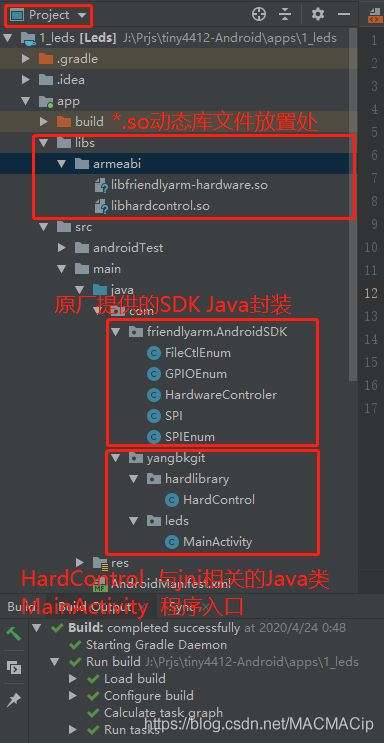在Android开发板跑一个LED驱动的历程(个人笔记)
【版权申明】未经博主同意,谢绝转载!(请尊重原创,博主保留追究权)
在Android开发板跑一个LED驱动的历程(个人笔记)
1. 板子端, 放置驱动程序
1.1 编写一个驱动程序
驱动程序的编写上, 与Linux是一致的, 无需关心任何Android相关的事物. 代码如下:#include 1.2 把1.1步骤的驱动程序编入Linux内核
Android使用的也是Linux内核, 所以将驱动程序编入内核也是和Linux一致的. 我的驱动文件放置在/drivers/char目录下的led_4412.c, 故打开/drivers/char目录下的Makefile, 添加如下一行:
obj-y += led_4412.o
然后退出到内核的根目录, make即可得到将驱动编入内核的zImage文件. 烧写进开发板
2. JNI安卓程序 C程序端
JNI是Java Native Interface的缩写, 它提供了若干的API实现了Java和其他语言的通信(主要是C&C++), 它允许Java代码和其他语言写的代码进行交互.
2.1 Makefile (编译.c文件的命令)
# to build *.so
CFLAG := -fPIC -shared
CFLAG += -I /usr/lib/jvm/java-1.7.0-openjdk-amd64/include/
# for can't find libc.so
CFLAG += -nostdlib /home/whistle/Tiny4412/Android-5.0.2/android-5.0.2/prebuilts/ndk/9/platforms/android-19/arch-arm/usr/lib/libc.so
# for liblog: fatal error: android/log.h: No such file or directory
CFLAG += -I /home/whistle/Tiny4412/Android-5.0.2/android-5.0.2/prebuilts/ndk/9/platforms/android-19/arch-arm/usr/include/
# for liblog: dlopen failed: cannot locate symbol "__android_log_print" referenced by "libhardcontrol.so"...
CFLAG += /home/whistle/Tiny4412/Android-5.0.2/android-5.0.2/prebuilts/ndk/9/platforms/android-19/arch-arm/usr/lib/liblog.so
all:
arm-linux-gcc hardcontrol.c -o libhardcontrol.so $(CFLAG)
2.2 C源码
#include 3. JNI安卓程序 安卓端
3.1 和jni相关的Java类
package com.yangbkgit.hardlibrary;
public class HardControl {
public static native int ledCtrl(int which, int status);
public static native int ledOpen();
public static native void ledClose();
static {
try {
System.loadLibrary("hardcontrol");
} catch (Exception e) {
e.printStackTrace();
}
}
}
3.2 ANdroid主程序
请自由发挥.
4. 期间遇到的一些小bug
4.1 open()函数返回-1
在板子端ls /dev/yangbkDevice -l发现除了root用户外其他用户没有读写权限, 所以会导致open()失败, 修改文件权限可以解决问题(Android开发板权限看来还是比较严格的)
10|shell@tiny4412:/ $ ls /dev/yangbkDevice -l
crw------- root root 253, 0 2020-04-23 17:27 yangbkDevice
解决办法:
su root
chmod 666 /dev/yangbkDevice
